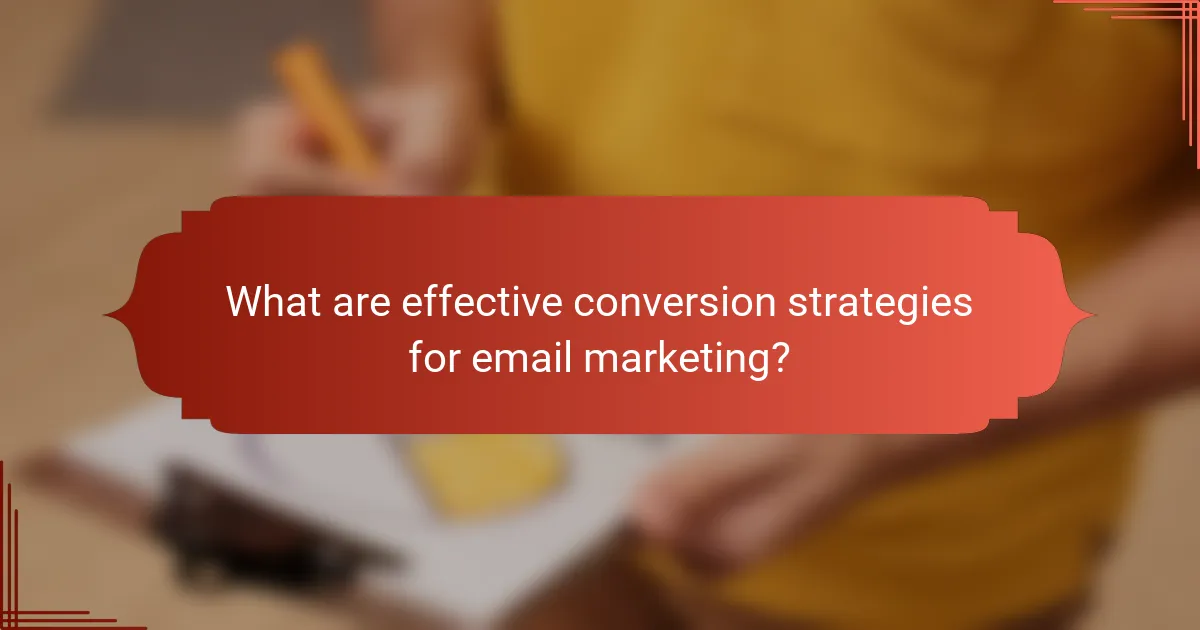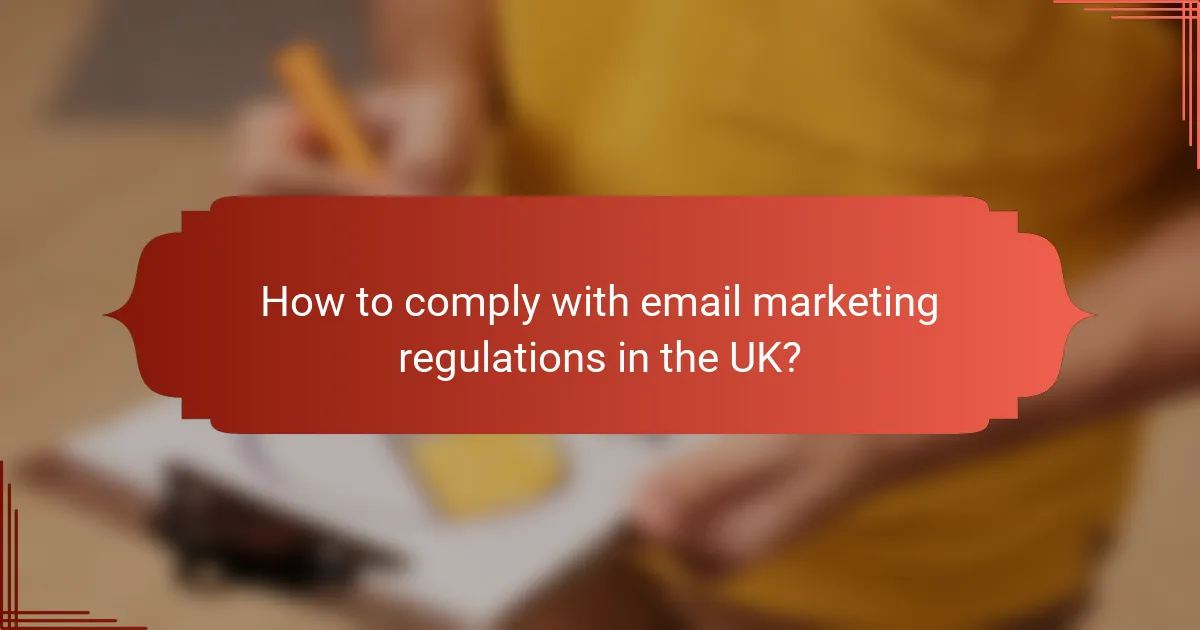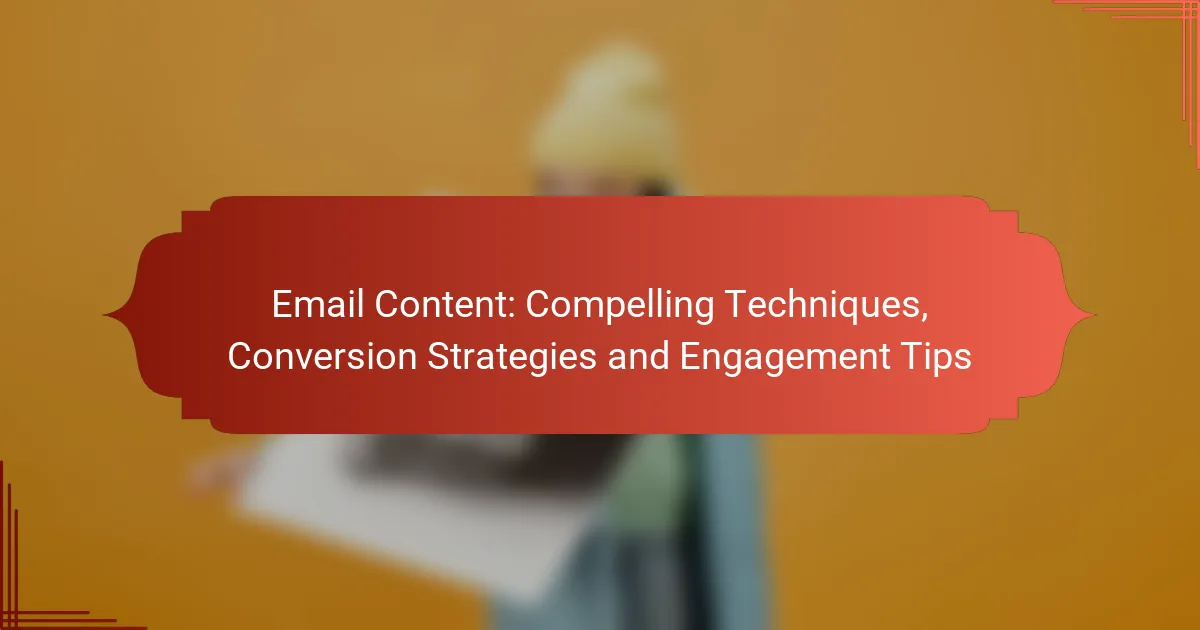Crafting compelling email content requires a deep understanding of your audience and the ability to create messages that resonate with them. By focusing on clarity and actionable insights, you can enhance engagement and drive conversions effectively. Implementing targeted strategies will not only boost your open and click-through rates but also foster a sense of connection with your recipients.

How to create compelling email content in the UK?
Creating compelling email content in the UK involves understanding your audience and crafting messages that resonate with them. Focus on clarity, engagement, and actionable insights to drive conversions and maintain interest.
Use attention-grabbing subject lines
Subject lines are the first impression of your email, making them crucial for open rates. Aim for concise, intriguing phrases that spark curiosity or highlight value, ideally under 50 characters.
Consider using numbers, questions, or personalization to enhance appeal. For example, “Unlock 20% Off Your Next Purchase!” can be more enticing than a generic discount announcement.
Incorporate storytelling techniques
Storytelling can make your email content more relatable and memorable. Share customer success stories or brand narratives that connect emotionally with your audience.
Use a clear structure: introduce a challenge, present a solution, and conclude with a positive outcome. This approach not only engages readers but also reinforces your brand message.
Utilize personalized content strategies
Personalization can significantly improve engagement rates. Use recipient names, past purchase history, or location-based offers to tailor content specifically for each reader.
Tools like dynamic content blocks can help automate this process, allowing you to send relevant messages that resonate with individual preferences and behaviors.
Include clear calls to action
Every email should guide readers towards a specific action, whether it’s making a purchase, signing up for a webinar, or downloading a resource. Use clear, direct language for your calls to action (CTAs).
Position CTAs prominently and consider using contrasting colors to make them stand out. Phrases like “Get Your Free Trial” or “Shop Now” can effectively prompt immediate responses.
Optimize for mobile devices
With a significant portion of emails opened on mobile devices, optimizing your content for smaller screens is essential. Use responsive design to ensure your emails look good on any device.
Keep text concise, use larger fonts, and ensure buttons are easily clickable. Test your emails on various devices to confirm that formatting and functionality remain intact.

What are effective conversion strategies for email marketing?
Effective conversion strategies for email marketing focus on optimizing engagement and driving actions from your audience. By implementing targeted approaches, you can significantly increase your open rates, click-through rates, and ultimately, conversions.
Segment your email list
Segmenting your email list involves dividing your subscribers into smaller groups based on specific criteria such as demographics, behavior, or purchase history. This allows you to tailor your messaging to meet the unique needs and interests of each segment, leading to higher engagement rates.
For instance, you might create segments for new subscribers, repeat customers, or those who have abandoned their carts. By sending personalized content to these groups, you can improve relevance and boost conversion rates.
Implement A/B testing
A/B testing, or split testing, is a method where you compare two versions of an email to determine which one performs better. This can involve testing different subject lines, layouts, or calls to action to see what resonates most with your audience.
Start by identifying one variable to test at a time, such as the subject line. Send version A to half your list and version B to the other half. Analyze the results to understand which version led to more conversions, and apply those insights to future campaigns.
Utilize urgency and scarcity tactics
Creating a sense of urgency or scarcity can motivate subscribers to act quickly. This can be achieved by highlighting limited-time offers, countdown timers, or low stock alerts in your emails.
For example, you might say, “Only 5 items left in stock!” or “Sale ends in 24 hours!” These tactics can create a fear of missing out (FOMO) that encourages immediate action, thereby increasing conversion rates.
Leverage social proof
Social proof involves using testimonials, reviews, or user-generated content to build trust and credibility with your audience. When potential customers see that others have had positive experiences with your product or service, they are more likely to convert.
Incorporate customer reviews or case studies into your emails to showcase satisfied customers. You might also include statistics, such as “Join over 10,000 happy customers!” to reinforce the value of your offering and encourage conversions.

How to enhance engagement with email campaigns?
Enhancing engagement with email campaigns involves creating content that resonates with your audience and encourages interaction. Focus on strategies that foster a two-way communication channel, making recipients feel valued and involved.
Encourage feedback and interaction
Inviting feedback from your audience can significantly boost engagement. Use surveys, polls, or direct questions in your emails to prompt responses. For example, ask readers to share their opinions on a recent product or service, which can also provide valuable insights for your business.
Make it easy for recipients to interact by including clear calls to action. For instance, a simple “Reply to this email with your thoughts!” can encourage more engagement than a generic request for feedback.
Use engaging visuals and multimedia
Incorporating visuals such as images, GIFs, or videos can make your emails more appealing and engaging. Studies show that emails with visuals tend to have higher open and click-through rates. Use high-quality images that relate to your content, and consider adding short videos to explain complex topics or showcase products.
Ensure that your visuals are optimized for mobile devices, as many users check emails on their phones. A responsive design that adjusts to different screen sizes can enhance the user experience and keep recipients engaged.
Offer exclusive content or promotions
Providing exclusive content or promotions can create a sense of urgency and encourage recipients to engage with your emails. Consider offering discounts, early access to new products, or members-only content that is not available elsewhere.
Clearly communicate the value of these offers in your subject lines and email body. For instance, “Exclusive 20% off for subscribers only!” can entice readers to open the email and take action. Regularly rotating your promotions can keep your audience interested and looking forward to your emails.

What metrics should you track for email success?
To measure email success, focus on key metrics such as open rates, click-through rates, and conversion rates. These indicators provide insights into how effectively your emails engage recipients and drive desired actions.
Monitor open rates
Open rates indicate the percentage of recipients who open your email compared to the total number delivered. A good open rate typically ranges from 15% to 25%, depending on your industry and audience. Tracking this metric helps you assess the effectiveness of your subject lines and sender reputation.
To improve open rates, consider A/B testing different subject lines and sending times. Avoid spammy language and ensure your sender name is recognizable to increase the likelihood of your emails being opened.
Analyze click-through rates
Click-through rates (CTR) measure the percentage of recipients who click on links within your email. A healthy CTR usually falls between 2% and 5%, but this can vary based on your sector and email content. Monitoring CTR helps you understand how compelling your content and calls to action are.
To boost CTR, use clear and enticing calls to action, and ensure your links are easily accessible. Segmenting your audience can also enhance relevance, leading to higher engagement rates.
Evaluate conversion rates
Conversion rates reflect the percentage of email recipients who complete a desired action, such as making a purchase or signing up for a webinar. A typical conversion rate for email campaigns can range from 1% to 5%. This metric is crucial for assessing the overall effectiveness of your email marketing strategy.
To improve conversion rates, ensure your landing pages are optimized for user experience and align with the email content. Use persuasive language and highlight benefits to encourage recipients to take action. Regularly review and refine your email campaigns based on conversion data to enhance performance.

What are the best practices for email list building?
Effective email list building involves strategies that attract and retain subscribers. Focusing on quality over quantity ensures that your audience is genuinely interested in your content and more likely to engage with your emails.
Utilize lead magnets
Lead magnets are incentives offered to potential subscribers in exchange for their email addresses. Common examples include free eBooks, exclusive discounts, or access to webinars. The key is to ensure that the lead magnet is relevant and valuable to your target audience.
When creating a lead magnet, consider what your audience truly needs. A well-designed lead magnet can significantly increase your conversion rates, often turning casual visitors into engaged subscribers.
Optimize landing pages
Your landing pages should be designed to convert visitors into subscribers effectively. This means having a clear call-to-action, concise messaging, and an attractive layout. A/B testing different elements, such as headlines and button colors, can help identify what works best.
Make sure your landing pages load quickly and are mobile-friendly, as many users access content via smartphones. A seamless experience can lead to higher sign-up rates and lower bounce rates.
Promote sign-ups on social media
Social media platforms are excellent channels for promoting your email sign-up forms. Share engaging posts that highlight the benefits of subscribing, and include direct links to your sign-up page. Consider using targeted ads to reach a broader audience.
Additionally, hosting contests or giveaways on social media can incentivize followers to subscribe. Ensure that you clearly communicate the value they will receive from your emails to encourage sign-ups.

How to comply with email marketing regulations in the UK?
To comply with email marketing regulations in the UK, businesses must adhere to the General Data Protection Regulation (GDPR) and the Privacy and Electronic Communications Regulations (PECR). This includes obtaining explicit consent from recipients before sending marketing emails and providing clear opt-out options.
Understand consent requirements
Under UK regulations, consent must be freely given, specific, informed, and unambiguous. This means that businesses should not use pre-ticked boxes or assume consent from inactivity. Instead, ensure that users actively opt-in to receive marketing communications.
For example, a clear checkbox stating, “I agree to receive marketing emails” should be included on sign-up forms. Additionally, keep records of consent to demonstrate compliance if required.
Provide clear opt-out options
Every marketing email must include a straightforward way for recipients to unsubscribe. This can be achieved by adding an “unsubscribe” link at the bottom of each email. Make sure the process is easy and does not require excessive steps.
For instance, a simple one-click unsubscribe option is ideal. Avoid making users log in or navigate through multiple pages to opt-out, as this can lead to frustration and potential complaints.
Maintain accurate records
Keeping accurate records of your email marketing activities is essential for compliance. This includes tracking consent, managing subscriber lists, and documenting any complaints received. Regularly review and update your records to ensure they reflect current subscribers and their preferences.
Consider using customer relationship management (CRM) software to streamline this process. This can help automate consent tracking and provide insights into subscriber engagement and preferences.
